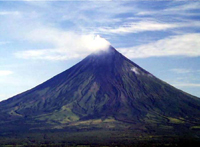Philippines: Mayon volcano ready to blow
The Philippine Institute of Volcanology and Seismology raised the alert to level 4, saying an explosive eruption appeared imminent. Level 5 represents an ongoing eruption.

Officials extended the danger zone to eight kilometres on the volcano's southern side, from seven kilometres earlier.
The new area included at least five neighbourhoods in Legaspi city, where classes were immediately suspended. Adjacent areas "should prepare for evacuation in the event explosive eruptions intensify," a volcanology institute advisory said.
Army trucks and other government vehicles have been deployed to ferry residents to at least 30 evacuation centres, Nunez added.
Gerry Losentales, a poor 87-year-old farmer, has refused to leave his hut near his small vegetable farm even after the land was partly seared by lava flows a few days ago. He was among dozens of residents ordered to evacuate Monday from Mabinit village below the volcano.
Lava began flowing July 14 and has been slowly extending down Mayon's slopes.
Earlier, volcanologists said they detected 21 low-frequency volcanic earthquakes in the last 24 hours. Renato Solidum, head of the volcanology institute, said the lava flow could continue, or the eruption could shift from quiet to explosive.
Brig. Gen. Arsenio Arugay, head of a task force that will respond to the situation, was given four to 10 hours to mobilize all concerned agencies.
Last week, the government deployed troops to keep sightseers away from the edge of advancing lava. Solidum earlier said the danger could come from collapse of the lava dome or a sudden explosive eruption that could send pyroclastic flows - clouds of superheated gas and ash - racing down the volcano's slopes.
Mayon is one of the Philippines' 22 active volcanos. Its most violent eruption, in 1814, killed more than 1,200 people and buried a town in mud. A 1993 eruption killed 79 people.
Subscribe to Pravda.Ru Telegram channel, Facebook, RSS!





